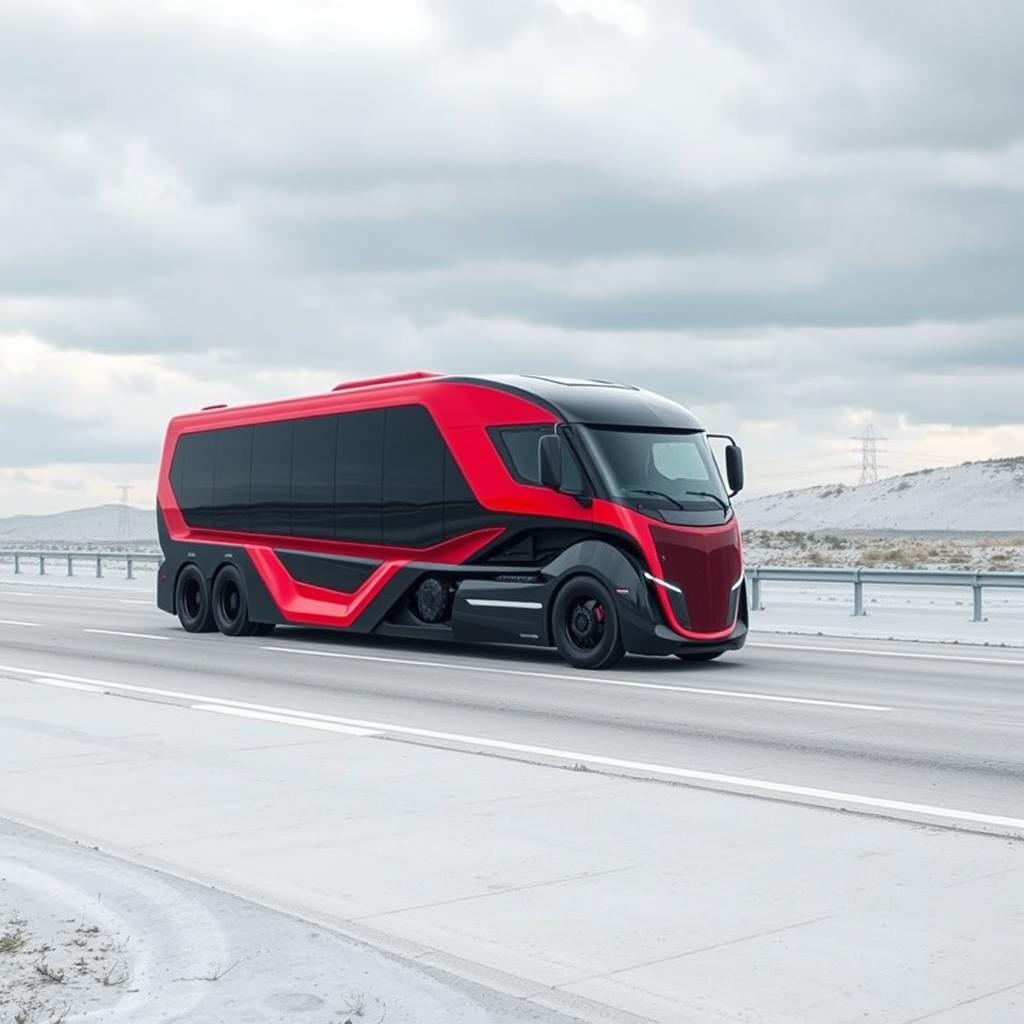Autonomous Trucking Revolution: USA Update
The landscape of transportation in the United States is on the brink of a monumental shift, with autonomous trucking developments in USA leading the charge. As we delve into this exciting frontier, it’s clear that the future of freight is being reshaped before our eyes. From coast to coast, innovative companies and forward-thinking policymakers are paving the way for a new era of efficiency, safety, and sustainability on our highways.
In this comprehensive exploration of the autonomous trucking revolution, we’ll navigate through the current state of affairs, examine the technologies driving this change, and consider the far-reaching implications for industries, economies, and communities across America. Buckle up as we embark on a journey through the fast-evolving world of self-driving trucks and discover how they’re set to transform the very fabric of our national infrastructure.
The Current State of Autonomous Trucking in the USA
The autonomous trucking industry in the United States has made significant strides in recent years, moving from concept to reality at an impressive pace. As of 2023, several key players have emerged, each pushing the boundaries of what’s possible in the realm of self-driving freight transport.
Leading Companies and Their Progress
- TuSimple: This San Diego-based company has been a pioneer in the field, successfully completing the first fully autonomous semi-truck run on open public roads without a human in the vehicle in 2021.
- Waymo: Alphabet’s self-driving technology company has expanded its operations to include autonomous trucking, with ongoing tests in multiple states.
- Aurora: Partnering with major truck manufacturers, Aurora has been making waves with its advanced driver assistance systems designed for long-haul trucking.
These companies, among others, are not just developing the technology in isolation. They’re actively collaborating with established truck manufacturers, logistics providers, and retailers to integrate autonomous systems into existing supply chains.
Regulatory Landscape
The regulatory environment for autonomous vehicles, including trucks, is evolving rapidly to keep pace with technological advancements. The U.S. Department of Transportation has been working on creating a framework that balances innovation with safety concerns. As of now, regulations vary by state, with some being more welcoming to autonomous vehicle testing than others.
Key regulatory developments include:
- The National Highway Traffic Safety Administration (NHTSA) updating its guidelines for automated driving systems.
- Several states, including Arizona, Texas, and Florida, passing legislation to facilitate autonomous vehicle testing and deployment.
- Ongoing discussions at the federal level about creating a unified national policy for autonomous vehicles.
As the technology matures, we can expect to see more comprehensive and standardized regulations emerge, providing clearer pathways for companies to bring their autonomous trucking solutions to market.
Technological Advancements Driving the Revolution
The autonomous trucking revolution is fueled by a convergence of cutting-edge technologies. Understanding these innovations is crucial to appreciating the full potential of self-driving trucks on American roads.
Sensor Technologies
At the heart of autonomous trucking are advanced sensor systems that allow vehicles to perceive their environment with incredible precision. These include:
- LiDAR (Light Detection and Ranging): Creates detailed 3D maps of the truck’s surroundings.
- Radar: Detects objects and measures their speed and distance.
- Cameras: Provide visual information and can read road signs and lane markings.
- Ultrasonic sensors: Offer precise measurements for close-range object detection.
The integration of these sensors allows autonomous trucks to navigate complex road conditions and make split-second decisions based on real-time data.
Artificial Intelligence and Machine Learning
The true power of autonomous trucking lies in the sophisticated AI algorithms that process sensor data and control the vehicle. Machine learning models are continuously trained on millions of miles of real-world driving data, allowing them to improve their decision-making capabilities over time.
These AI systems can:
- Predict the behavior of other vehicles and pedestrians
- Optimize routes for fuel efficiency and delivery times
- Adapt to changing weather and traffic conditions
- Identify and respond to potential safety hazards
Vehicle-to-Everything (V2X) Communication
V2X technology enables autonomous trucks to communicate with other vehicles, infrastructure, and even pedestrians. This constant exchange of information creates a more connected and safer driving environment. For instance, trucks can receive real-time updates about road conditions, traffic flow, and potential hazards, allowing them to adjust their routes and driving behavior accordingly.
As these technologies continue to advance, we can expect to see even more sophisticated autonomous trucking systems that can handle increasingly complex driving scenarios with greater reliability and efficiency.
Economic Impact and Industry Transformation
The rise of autonomous trucking is set to have a profound impact on the U.S. economy and the trucking industry as a whole. While the full extent of these changes is still unfolding, several key areas are already showing significant potential for transformation.
Cost Savings and Efficiency Gains
One of the most immediate and tangible benefits of autonomous trucking is the potential for substantial cost savings. According to a McKinsey report, the total cost of ownership for autonomous trucks could be 45% lower than traditional trucks by 2030. These savings come from several factors:
- Fuel efficiency: AI-optimized driving patterns can significantly reduce fuel consumption.
- Labor costs: While human operators will still be needed for certain tasks, the role of drivers will evolve, potentially reducing overall labor costs.
- Maintenance: Predictive maintenance powered by onboard sensors can reduce downtime and repair costs.
- Insurance: As safety improves, insurance premiums are expected to decrease.
These cost reductions could lead to lower shipping rates, benefiting businesses and consumers alike.
Job Market Shifts
The impact of autonomous trucking on employment is a topic of much debate. While there are concerns about potential job losses for truck drivers, the reality is likely to be more nuanced:
- Evolution of driver roles: Many experts predict that drivers will transition to “operators” who manage autonomous systems and handle non-driving tasks.
- New job creation: The autonomous trucking industry will create new roles in areas such as fleet management, remote monitoring, and specialized maintenance.
- Addressing driver shortages: Autonomous technology could help alleviate the ongoing truck driver shortage in the USA.
It’s crucial for industry stakeholders to work together to ensure a smooth transition and provide retraining opportunities for workers affected by these changes.
Supply Chain Optimization
Autonomous trucking has the potential to revolutionize supply chain management:
- 24/7 operations: Self-driving trucks can operate around the clock, reducing delivery times and increasing overall freight capacity.
- Predictable transit times: AI-powered route optimization and consistent driving patterns lead to more accurate delivery estimates.
- Improved inventory management: More reliable shipping times allow for leaner inventory practices and just-in-time delivery systems.
These improvements could lead to more resilient and responsive supply chains, better equipped to handle disruptions and meet consumer demands.
Safety Implications and Public Perception
As autonomous trucking developments in USA continue to accelerate, safety remains a paramount concern. The potential for improved road safety is one of the most compelling arguments in favor of self-driving trucks, but it’s also an area that requires careful consideration and ongoing research.
Potential Safety Benefits
Proponents of autonomous trucking argue that it could significantly reduce road accidents and fatalities. Here’s why:
- Elimination of human error: According to the NHTSA, human error is a factor in approximately 94% of serious crashes. Autonomous systems don’t get distracted, fatigued, or impaired.
- Consistent adherence to traffic laws: Self-driving trucks are programmed to follow speed limits and other traffic regulations consistently.
- Enhanced perception: Advanced sensor systems can detect potential hazards faster than human drivers and in conditions with low visibility.
- Predictive capabilities: AI can anticipate and react to potential dangers before they become immediate threats.
Early data from autonomous trucking trials have shown promising safety results, with fewer incidents compared to human-driven trucks over similar distances.
Addressing Safety Concerns
Despite the potential benefits, there are still valid safety concerns that need to be addressed:
- System failures: Ensuring robust failsafes and redundancies in case of technical malfunctions.
- Cybersecurity: Protecting autonomous trucks from potential hacking or unauthorized control.
- Interaction with human drivers: Ensuring smooth integration of autonomous trucks with traditional vehicles on the road.
- Ethical decision-making: Programming vehicles to make appropriate choices in complex moral scenarios.
Industry leaders and regulators are actively working on solutions to these challenges, including rigorous testing protocols, advanced encryption methods, and the development of ethical frameworks for AI decision-making.
Public Perception and Acceptance
The success of autonomous trucking will depend largely on public acceptance. Current public opinion on self-driving vehicles is mixed, with many people expressing concerns about safety and job displacement. However, attitudes are evolving as the technology becomes more visible and its benefits more apparent.
To improve public perception, stakeholders in the autonomous trucking industry are focusing on:
- Transparency: Sharing safety data and testing results with the public.
- Education: Informing the public about how autonomous systems work and their potential benefits.
- Gradual implementation: Introducing autonomous features incrementally to build trust over time.
- Community engagement: Involving local communities in the rollout of autonomous trucking initiatives.
As more people become familiar with autonomous vehicles and witness their safe operation, it’s likely that public acceptance will grow. However, building this trust will require ongoing efforts from industry players and policymakers alike.
Environmental Impact and Sustainability
The autonomous trucking revolution isn’t just about efficiency and safety; it also has significant implications for environmental sustainability. As the transportation sector is a major contributor to greenhouse gas emissions, the potential for autonomous trucks to reduce the environmental impact of freight transport is generating considerable interest.
Fuel Efficiency and Emissions Reduction
Autonomous trucking systems have the potential to significantly reduce fuel consumption and, consequently, emissions:
- Optimized driving patterns: AI-controlled trucks can maintain optimal speeds and acceleration patterns, reducing unnecessary fuel consumption.
- Platooning: Autonomous trucks can travel in close formation, reducing air resistance and improving fuel efficiency for all vehicles in the platoon.
- Route optimization: AI systems can choose the most fuel-efficient routes, taking into account factors like traffic, elevation changes, and weather conditions.
According to a study by the U.S. Department of Energy, these factors combined could lead to fuel savings of up to 10% for long-haul trucks.
Integration with Electric and Alternative Fuel Technologies
The autonomous trucking revolution is coinciding with advancements in electric and alternative fuel technologies. This synergy has the potential to dramatically reduce the carbon footprint of the trucking industry:
- Electric autonomous trucks: Companies like Tesla and Volvo are developing electric semi-trucks with autonomous capabilities, combining zero-emission operation with the efficiency of self-driving systems.
- Hydrogen fuel cell trucks: Autonomous systems can optimize the use of hydrogen fuel cells, potentially making this clean energy source more viable for long-haul trucking.
- Smart charging and refueling: AI can manage charging or refueling schedules to maximize efficiency and take advantage of off-peak energy rates.
Reduced Traffic Congestion
Autonomous trucks can contribute to reduced traffic congestion, which has positive environmental implications:
- Smoother traffic flow: AI-controlled trucks can maintain consistent speeds and spacing, reducing the stop-and-go patterns that contribute to congestion and increased emissions.
- Off-peak operation: Autonomous trucks can operate during off-peak hours, reducing daytime traffic and spreading the load on road infrastructure more evenly.
- Fewer accidents: By potentially reducing the number of accidents, autonomous trucks can help prevent the traffic jams and increased emissions associated with road incidents.
As the technology matures and becomes more widespread, we can expect to see a significant positive impact on the environmental footprint of the trucking industry. This aligns well with broader sustainability goals and could help the United States make progress towards its emissions reduction targets.
The Road Ahead: Challenges and Opportunities
As we look to the future of autonomous trucking in the USA, it’s clear that while the potential benefits are enormous, there are still significant challenges to overcome. Understanding these challenges, as well as the opportunities they present, is crucial for anyone looking to navigate this rapidly evolving industry.
Regulatory Hurdles
One of the primary challenges facing the autonomous trucking industry is the need for clear, comprehensive regulations at both the state and federal levels. Current regulatory frameworks were not designed with self-driving vehicles in mind, and updating them is a complex process.
Key regulatory challenges include:
- Establishing safety standards for autonomous systems
- Determining liability in case of accidents
- Creating protocols for interaction between autonomous and human-driven vehicles
- Addressing cross-state regulatory differences
However, these challenges also present opportunities for innovative policymaking and collaboration between industry and government. Companies that actively engage in shaping these regulations may gain a competitive advantage.
Infrastructure Adaptation
While autonomous trucks are designed to operate on existing roads, optimizing infrastructure for self-driving vehicles could enhance their performance and safety. This includes:
- Upgrading road markings and signage for better machine readability
- Implementing smart traffic management systems
- Creating dedicated lanes or corridors for autonomous vehicles
- Developing standardized charging or refueling stations for electric and alternative fuel autonomous trucks
These infrastructure projects represent significant investment opportunities and could create jobs in construction, engineering, and technology sectors.
Technological Refinement
While autonomous trucking technology has made remarkable progress, there’s still room for improvement in areas such as:
- Enhancing AI decision-making in complex or unpredictable scenarios
- Improving sensor performance in adverse weather conditions
- Strengthening cybersecurity measures
- Developing more efficient and durable hardware components
These challenges present opportunities for innovation and collaboration between tech companies, traditional automotive manufacturers, and research institutions.
Workforce Transition
As mentioned earlier, the shift towards autonomous trucking will necessitate changes in the workforce. While this presents challenges, it also offers opportunities for:
- Developing new training programs for roles in autonomous fleet management and maintenance
- Creating more attractive, tech-focused career paths in the trucking industry
- Addressing the current driver shortage with new technology-oriented roles
Companies and educational institutions that proactively develop programs to facilitate this transition could play a crucial role in shaping the future workforce of the trucking industry.
Public Acceptance and Education
Building public trust and acceptance of autonomous trucking technology remains an ongoing challenge. However, this also presents opportunities for:
- Innovative public relations and education campaigns
- Collaboration between industry, government, and community organizations
- Development of transparent safety reporting and incident response protocols
Companies that successfully address public concerns and demonstrate the benefits of autonomous trucking could gain a significant advantage in terms of public support and customer trust.
As we navigate these challenges and opportunities, it’s clear that the autonomous trucking revolution in the USA is not just about technology – it’s about reimagining the entire transportation ecosystem. Those who can adapt, innovate, and collaborate effectively will be well-positioned to lead in this new era of freight transport.
Conclusion: Embracing the Autonomous Future
As we’ve explored throughout this article, the autonomous trucking revolution is set to reshape the transportation landscape in the United States. From enhanced safety and efficiency to reduced environmental impact and new economic opportunities, the potential benefits are substantial. However, realizing this potential will require ongoing collaboration, innovation, and adaptation from all stakeholders in the industry.
For businesses and individuals looking to stay ahead of the curve in this rapidly evolving field, now is the time to engage with the autonomous trucking revolution. Whether you’re a fleet operator considering the integration of autonomous technologies, a technology professional interested in the cutting-edge AI and robotics applications, or a policymaker grappling with the regulatory challenges, there are numerous ways to get involved and shape the future of transportation in America.
At [Your Company Name], we’re committed to helping our clients navigate the exciting world of autonomous trucking. Our team of experts stays at the forefront of industry developments, providing insights, solutions, and support to businesses looking to leverage these transformative technologies.
Don’t let the autonomous trucking revolution pass you by. Contact us today to learn how we can help you prepare for and thrive in the new era of freight transport. Together, we can drive towards a safer, more efficient, and sustainable future on America’s highways.







